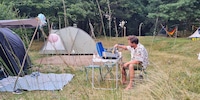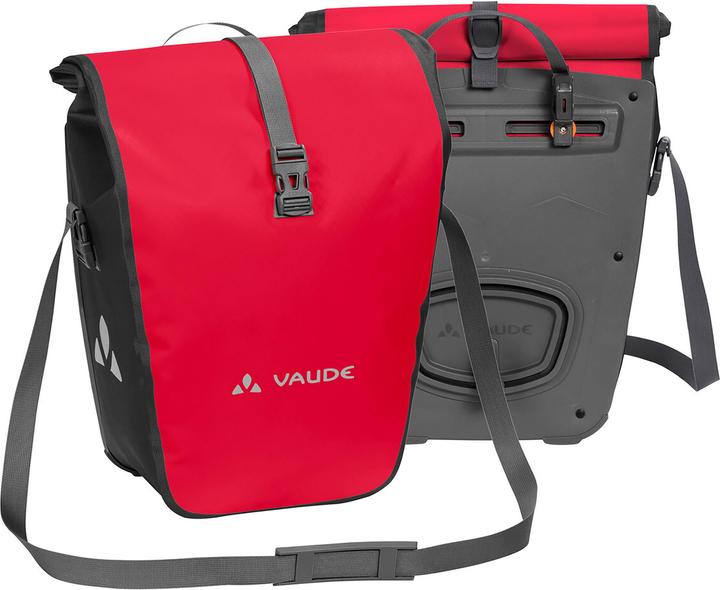

Siri’s outdoor lab: how to make a last-minute camping trip a success
It’s good to just get outside at the weekends. To get on your bike and take off. Recently, I packed my bike bags with a 509-gramme tent, sleeping bag and sleeping mat and did exactly that, before spending a wonderful night under the stars.
Sometimes you just need a brief change of scenery. Fresh air, exercise, a spot of nature and a night spent sleeping under the stars. Not only are mini adventures like this relaxing, but they give you a well-deserved break from ever-present screens and everyday routines.
One Saturday morning, I spontaneously decided to go on a two-day bike trip. Though it was still drizzling a little, the weather forecast for the rest of the weekend looked good. On Nomady.camp, I found a farm not too far away offering overnight camping spots in the meadow for a fee. With wild camping banned in many places, Nomady and similar platforms are good alternatives for people who don’t fancy the bustle of an established campsite.
Lightweight equipment that doesn’t sacrifice your comfort
Since I had to fit my outdoor bedroom, some clothes and a camera into my bike bags, I was glad I’d been given Scottish manufacturer Vango’s F10 Neon UL1 tent a few weeks beforehand to review. Weighing just 509 grammes and taking up very little space in a bag, I reckoned it could be ideal for a solo overnight trip. I also opted to take my Aotrom Thermo Platinum sleeping mat (another Vango product). Thanks to its platinum coating, it promises good thermal performance at a weight of 610 grammes.
There was no way I’d leave without my Grüezi Bag, the Biopod Down Wool Subzero sleeping bag I’ve already reviewed in detail and whose comfy warmth I just can’t do without. As an outdoor guide, I often sleep under the stars, so getting a good night’s kip is a priority for me.
My favourite travel pillow is the Cocoon Air Core Pillow Microlight. Partly because of its light weight, and partly because, for an inflatable pillow, it makes pleasantly little noise when I turn my head at night.
Stowed away in waterproof bike bags
When I go away for the weekend, I pack my stuff into the same bike bags I use for commuting to the office: Vaude Aqua Back bags. The bags are robust, well made and – most crucially in my opinion – waterproof. After all, I need to keep my electronic devices and camping equipment dry. The bags can easily be clicked on to your bike’s luggage rack, and are ready to go in no time.
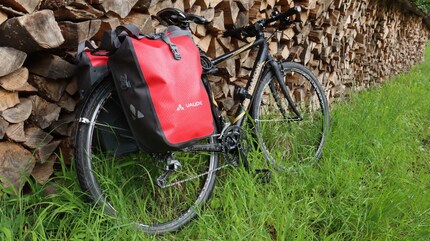
Source: Siri Schubert
Through the hilly Seetal valley to my camping spot
Despite my best efforts to make sure my luggage is lightweight and low in volume, my bike bags are still full. With the luggage making its presence felt on inclines in particular, I cycle slowly and nonchalantly.
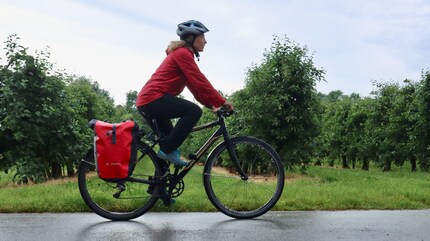
Source: Siri Schubert
The goal is to enjoy myself, not to set a racing record. Having brought as few spare Merino wool outfits with me as possible, I also want to keep sweating to a minimum. When I arrive at the farm, I’m wowed by the peace and quiet and the beautiful view over the Seetal valley. In the farmyard, there’s a rustic toilet, a shower and a coffee machine for guests. Perfect.
Good things come in small packages: this tent only sleeps one
When I go off on short solo trips, I usually take a tarp, a bivouac sack or a hammock to save weight and space. A tent, however, is much more comfortable. Unlike when sleeping under a tarp, you’re better protected from the wind and critters crawling over your face (looking at you, snails). You’re also less likely to have the issue of condensation dripping onto your sleeping bag than when you’re in a bivouac sack.
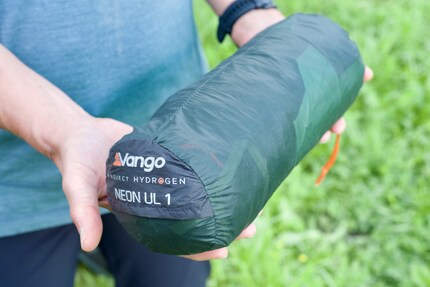
Source: Siri Schubert
It’s now time to pitch my tent. Dealing with its foldable pole is easy once you get the hang of it, but it’s not exactly intuitive. Sure, I should have looked at the online instructions first, but these things fall by the wayside when you’re going on a spontaneous trip. Once you’ve done it once, however, pitching the tent really is child’s play. Since the inner and outer tents go up together, it only takes a few minutes.
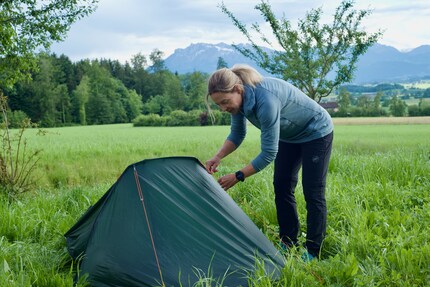
Source: Siri Schubert
As far as the dimensions are concerned, the mini tent is perfect for one person:
- Length: 230 centimetres
- Width: 120 centimetres
- Height: 70 centimetres
- Pack size: 27 x 8 x 22 centimetres
- Weight: 509 grammes
For a 164-centimetre-tall person like me, the tent is pretty roomy. I can easily store my camera and other valuables by my head. Taller people, on the other hand, won’t have as much space.
Well-implemented, handy features
I really like the mini awning, which keeps shoes and other things needing to be kept dry within easy reach. The inner tent keeps out bugs and any other unwanted guests, while the pole-supported, raised foot end prevents me from accidentally touching the outer skin of the tent and allowing moisture to seep in.
In my opinion, the side entrance is the best thought-out feature. I can easily crawl in and out through the large opening. Whenever I’m sleeping in a small tent with a front entrance and the tarp’s stretched low because it’s a windy night, I often have no choice but to shimmy my way out over the ground on my belly. A seriously unpleasant experience in wet weather. Maybe I just don’t have the flexibility for it. The Vango tent, on the other hand, allows me to stay dry while getting out of the tent – even without several years of yoga under my belt.
I’m not surprised that the tent has these thoughtful details. The Scottish company Vango has been doing business in the outdoor sector since 1966. It’s poured the experience it’s amassed during that time into its products, which range from small, ultralight tents to large family tents.
A night under the stars
Once the evening creeps in, I climb through the opening into the tent and sink comfortably into my Aotrom Thermo mat. Thanks to its structured surface and air channels, it adapts to the shape of my body. I read for a while using the light of my headlamp before falling asleep.
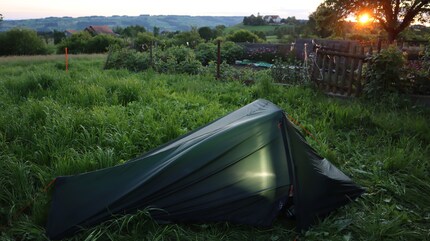
Source: Siri Schubert
I wake up a few times during the night. That’s typical for me on the first night of a camping trip because the unfamiliar noises immediately put my brain into alert mode. It felt comfortable to lie on my back on the mat, but because I turned onto my side in my sleep, my shoulders and hips started pressing into the ground. That’s to be expected, as the Aotrom’s only about five centimetres thick. As a side sleeper, I prefer 10-centimetre-thick sleeping mats. So I roll back onto my back and fall asleep again.
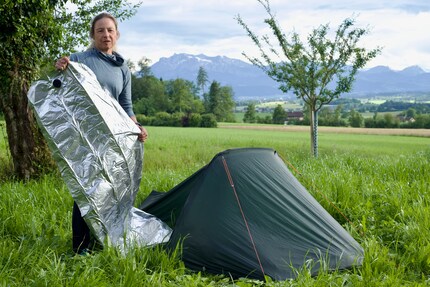
Source: Siri Schubert
I wake up in the morning feeling pretty refreshed – and warm. Not the stuffy, sweaty warmth you sometimes get while camping, but a pleasant, cosy warmth. And this is despite the temperature dropping to five degrees during the night. My cosiness was certainly partly down to the Grüezi Bag sleeping bag, which had impressed me on previous trips with its good thermoregulation. The Aotrom Thermo mat’s insulation also contributed to keeping me at a comfortable temperature while I slept. After all, if I’m well shielded from the cold from below, my body temperature’s less inclined to drop.
In fact, a heat-insulating sleeping mat is vital for getting a good night’s sleep when camping. This is because the ground is usually much colder than the air. Since the underside of the sleeping bag is compressed under your body, it doesn’t warm you up as effectively. This is where a sleeping mat comes in handy, ensuring that the coldness of the ground doesn’t get into your bones.
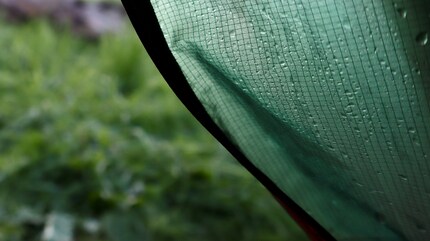
Source: Siri Schubert
I also stayed dry. Although plenty of dew had collected on the outer skin of the tent, none of it managed to get inside. The F10 Neon UL1’s silicone-coated outer shell did a good job.
Good gear for short, spontaneous adventures
Weighing just over 500 grammes and with a compact pack size, the tent is easy to take on your adventures. The next morning, it easily fits back into its cover. Since the fabric is very thin, the tent needs to be packed away carefully so as to avoid accidentally damaging it with the pegs or poles.
The Vango F10 Neon UL1 is suitable for bikepacking, trekking, packrafting and canoe trips, multi-day trail running events and other multi-phase events. As it offers more protection and better temperature and moisture management, I see it as a good alternative to a tarp or bivy sack.
The Aotrom Thermo mat impressed me in terms of its warmth, light weight (610 grammes) and pack size. With an R-value (thermal resistance) of 4.2, the mat is suitable for all four seasons. Since I’m a side sleeper, I prefer thicker mats like this one, but that’s a question of taste. It’s also a question of price – the Vango mat’s much cheaper.
We don’t have the new F10 Neon UL1 in our range yet, but if you just can’t wait to head out on your adventure, I’ve got a couple of recommendations for you. There’s the F10 Hydrogen Air with air poles, which, at 700 grammes, is still very light. Or there’s the F10 Helium UL1, which weighs just 1.25 kilos.
In my «Siri’s outdoor lab» series, I test new trends, ingenious hacks and outdoor and sports equipment under real-life conditions. Follow me for more outdoor microadventures and tips on how to make the most of them.
Research diver, outdoor guide and SUP instructor – I love being in, on and around water. Lakes, rivers and the ocean are my playgrounds. For a change of perspective, I look at the world from above while trail running or flying drones.
Interesting facts about products, behind-the-scenes looks at manufacturers and deep-dives on interesting people.
Show all



